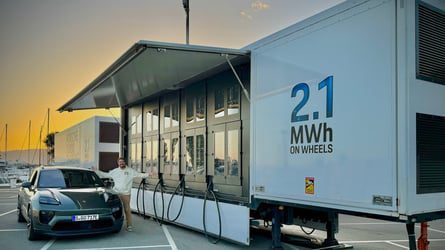Watch Porsche’s Portable DCFC Charger Juice Up The Macan Electric
Kyle from the Out of Spec YouTube channel recently had the opportunity to go on-site to the French Riviera. There, he had some quality time behind the wheel of the beautiful new Porsche Macan Electric. But as a true electric car nerd, Kyle was just as fascinated by this cool piece of portable EV charging tech from Porsche.
The Porsche Turbo Charging portable DC fast chargers (DCFC) have served as a charging solution for the automaker since 2019. Porsche has seven of these charging trailers deployed across Europe. It has been an excellent solution to many different charging scenarios like powering prototype testing, marketing and test drive events and track days.
While we have seen similar technologies since, the specs on Porsches’ charge system remain quite impressive. Most other systems are much smaller in scope. The trailer featured weighs a whopping 70,000 lbs, has a 2.1 MWh battery capacity and can support a 3.2 MW load. There are ten plugs on the unit that can dispense 320 kW each, with the battery packs supporting ~400 amp peak discharging.
In the example here, the trailer is plugged into the grid to replenish the battery pack, but the trailer’s “Island Mode” allows it to work completely off battery power. When directly connected to power at this location, a series of five heavy-duty cords are run from the power source to the trailers with a specialty-designed plug and a converter to get a 5-pin, 3-phase red plug with a neutral and a ground.
Each trailer’s massive battery pack can be replenished from the grid in about four hours. When the pack’s capacity is full while connected to power, the AC to DC converter can serve as a passthrough to charge the car directly, bypassing the battery pack.
When the trailer is in its island mode, it can also balance the charge levels across all of the battery packs. This is a very inefficient process, however, since there is no DC-to-DC connection between them. As a result, this requires two conversions from DC to AC and then back from AC to DC. So they avoid this when possible.
There are lots of other interesting technical details, so if you are interested in battery and EV charging technologies, be sure to check out the full video.
51 Photos







